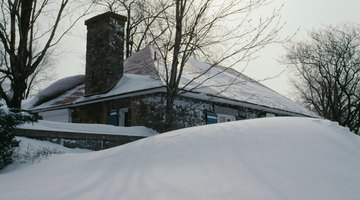How to Prevent a Sewer Vent Freeze Up
Sewer vents serve as part of the home drain-waste-vent system, helping remove waste from toilets, sinks and showers. When the vent freezes up -- often indicated by the “rotten egg” smell of hydrogen sulfide -- it can cause you or family to become ill or even create explosive gas in the home.

Because sewer vents are part of an interconnected plumbing system, you'll have to attack from a few fronts to prevent freezing.
Things You Will Need
- Snow-clearing implements
- Heat register
- Foil-backed insulated sleeve or thermostatically controlled tape
- Copper "T" or heat cord
-
Clear your roof of snow on a regular basis. Excessive snow on the roof can block the vent's stack and cause freezing. A gurgling toilet may indicate a clogged or frozen vent stack. If this happens, pour warm water down the roof's sewer vent stack.
-
Pour warm water down rarely-used household drains during the winter season. Slowly pour water down basement drains and any unused toilets or showers. This keeps water in the drain-waste-vent system's trap, preventing freezing.
-
Keep your attic heated. Install a heat register vent in the attic to produce warm air flow and prevent sewer vent components from freezing.
-
Wrap a foil-backed insulated sleeve around the vent pipe in the attic. You can also use thermostatically controlled tape for this job.
-
Have a plumber install a copper “T” or heat cord in your sewer vent. These components retain heat as it rises through the vent. The utility may justify the price tag in extremely cold areas where vent freeze ups occur regularly, especially in modern homes that use ABS or PVC pipes, which don't conduct heat as well as old-fashioned cast iron pipes.
The Drip Cap
- Sewer vents serve as part of the home drain-waste-vent system, helping remove waste from toilets, sinks and showers.
- When the vent freezes up -- often indicated by the “rotten egg” smell of hydrogen sulfide -- it can cause you or family to become ill or even create explosive gas in the home.
- Clear your roof of snow on a regular basis.
- Install a heat register vent in the attic to produce warm air flow and prevent sewer vent components from freezing.
References
Writer Bio
Dan combines his decade-long experience as a freelance writer with hands-on experience in landscaping, flooring, painting, maritime maintenance and handy man work. Previously, he's published with Black+Decker, Geeks On Home, GardenGuides.com, GOBankingRates.com, USA Today, SFGate Home and others.
Photo Credits
- Photos.com/Photos.com/Getty Images
- Photos.com/Photos.com/Getty Images
More Articles



